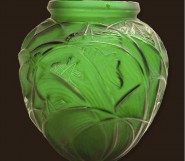Lot #105 - Two Early 20Th Century Engraved Boab Nuts, Broome, W.A.
-
Auction House:Leonard Joel
-
Sale Name:Aboriginal Art & Artefacts
-
Sale Date:10 Oct 2013 ~ 6.30pm
-
Lot #:105
-
Lot Description:Two Early 20Th Century Engraved Boab Nuts, Broome, W.A.
naturalistic motifs engraved ,most likely with a metal instrument, and infilled with red ochre and rich, deep patina. i) Three brolgas or cranes with stippled lines under red ochre, two animals engraved with parallel lines and a four-leaf plant; ii) Three Emus and three chicks, all striped except for one Emu that is stippled under red ochre, a striped beast and map-like linear motif
i) 11.5cm (length); ii) 11.5cm (length) -
Provenance:Collected by Hugh Leona Richardson, general agent and Broome master pearler until c.1929; Thence by descent, VIC
-
References:A Brief Description of Three Early 20th Century Engraved Boab Nuts from Broome, Western Australia by Kim Akerman
-
Notes:The following descriptions refer to three engraved nuts of the Boab tree (Adansonia gregorii) that are believed to have been collected by Broome master pearler and general agent, H. L. (Hugh Leona) Richardson. Richardson (1882-1971) was based at Broome in the first half of the 20th century. Being so completely identified with the Kimberley region boab nuts engraved by Aboriginal artists were a favourite souvenir of trips to the far north west and were also sent out of the area as gifts to family and friends in more settled regions of the continent. They were also collected locally and kept by Kimberley residents who either knew the artists personally or admired the handiwork of particular artists. Unfortunately in the majority of cases the names or gender of the artists were never recorded. While women possibly made up the majority of boab nut artists, by the mid-20th century it is not known if they always have carved them. Two of the three nuts appear to have been carved by the same artist. Using a fine rocking motion with the tip of a pocket knife - the consistent amplitude and dimensions of the lines suggest a metal rather than stone or glass implement - the artist has carved a number of naturalistic motifs along with rather enigmatic animals, or symbols, on both nuts. The third nut is carved in a manner described as traditional naturalistic, that is the motifs appear similar to those found made in pre-contact times on the walls of rock shelters or caves or painted on weapons and implements. The first nut shows three cranes or brolgas. Two are - one above, and the other below - adjacent to a rather strange striped animal with a long curved muzzle. A second striped, animal similar to the first but with a shorter triangular head, is placed on the other side of the nut. Whether the animals are meant to represent a horse, a sheep or a dog cannot be determined but they are both carefully executed and their bodies have been carefully infilled with pleasing arrangements of parallel engraved lines. In the case of the first beast, the lines are arranged as two sets of opposing arcs while the sheep/dog is infilled with opposed sets of parallel diagonal lines. A simple plant-like structure composed of a vertical line with two sets of opposed oval 'leaves' is placed above the latter animal. The second nut shows three large emus striding along accompanied by three striped chicks. There is a really strange, animal-like figure made up of parallel lines following the contours of the beast, if that is what it is, and a second more regular geometric figure like an open maze with rounded as well as straighter sections. These last motifs may in fact refer to sites or country. The third nut is engraved in the traditional naturalistic manner with four crocodiles. The bodies of two of the crocodiles are infilled with broad, black and red painted and engraved chevrons, while the bodies of the third and fourth crocodiles are left plain - the artist just scraping the nut to expose a lighter inner surface. A rather angular snake infilled with parallel bands meanders around the top of the nut adjacent to the stem. The head of the snake terminates above a rendition of a rather pugilistic kangaroo or wallaby and, with a quite stunned appearance, it seems to sight a large-billed bird that is rather lugubriously eyeing it. The final figure on this nut is an owl-like bird with very human features. Such figures are not uncommon in the rock art associated with Wanjina figures in the northern and central Kimberley. Along with the crocodiles, snake and wallaby - this figure suggests that the artist was not from the Broome area but further north. Broome artists tended to focus on themes associated with marine life and the maritime economy of the area. Possibly the artist was a prisoner brought into Broome prison from 'across the Ranges'. As well as being engraved in the normal manner the nuts have also had red ochre applied to them and in the case of the third nut the chevrons on the crocodiles seem to have been deliberately tinted with either ochre or crayon. All three nuts have a deep and rich patina that comes with handling and time. It is rare these days to find such early boab nuts to which a particular collector and time period can be ascribed. Apart from their own intrinsic merit the association with the historic pearling centre of Broome and a Master Pearler makes these particular boab nuts particularly interesting. September 2013.
-
Estimate:A$800 - 1,200
-
Realised Price:
-
Category:Tribal
This Sale has been held and this item is no longer available. Details are provided for information purposes only.










